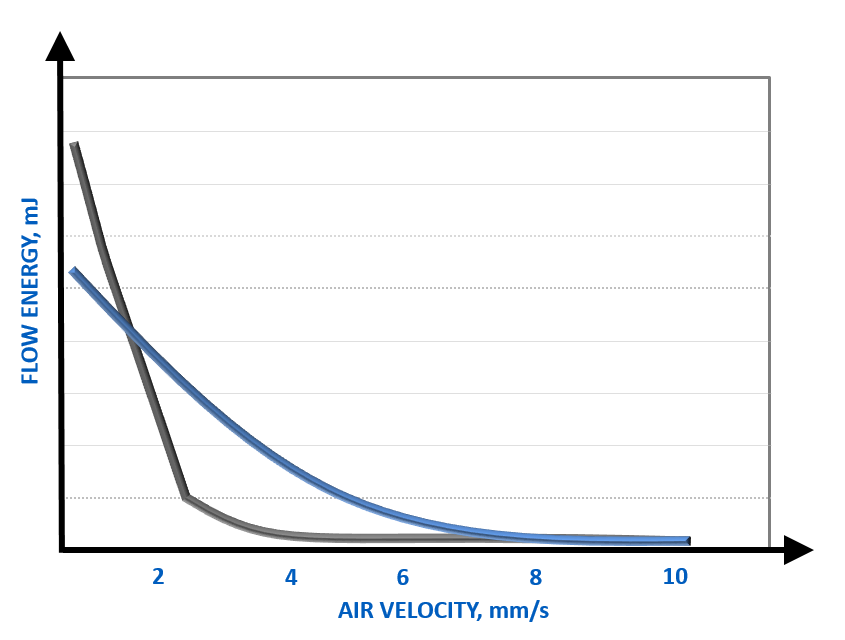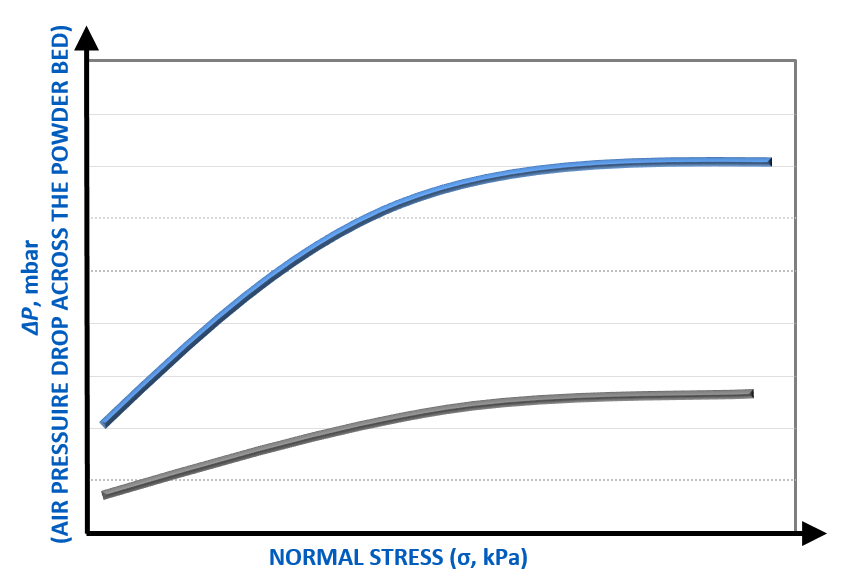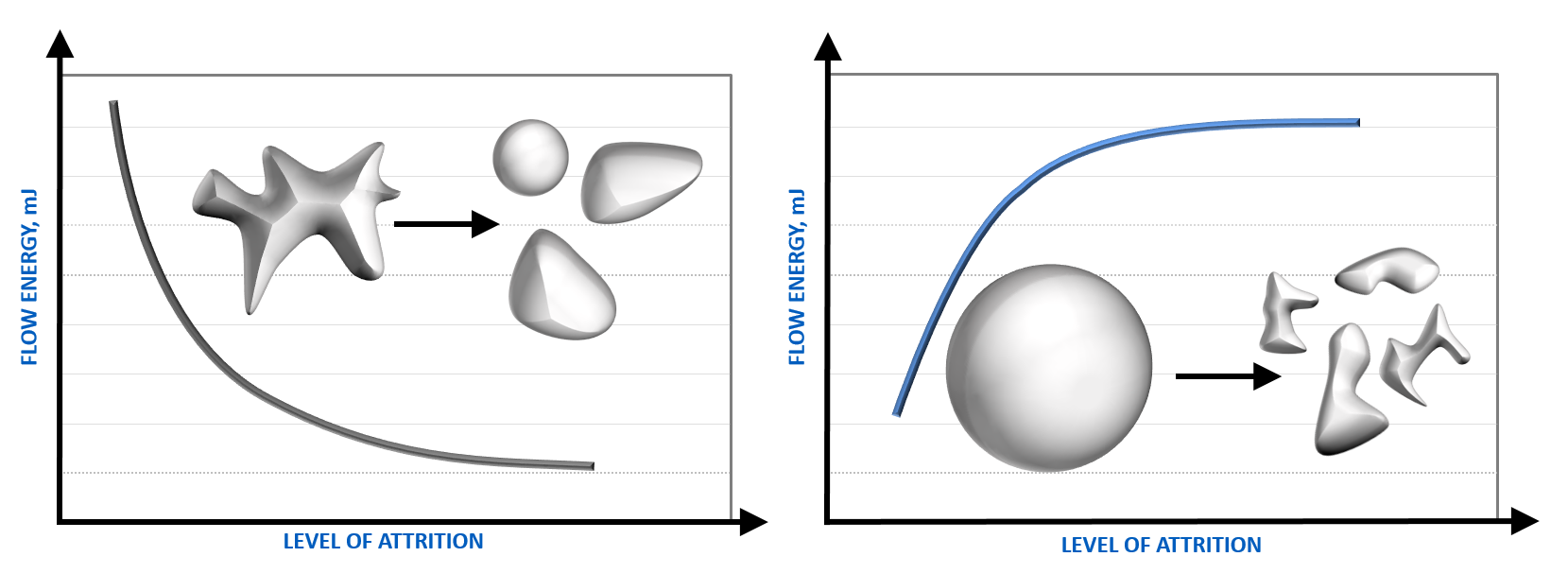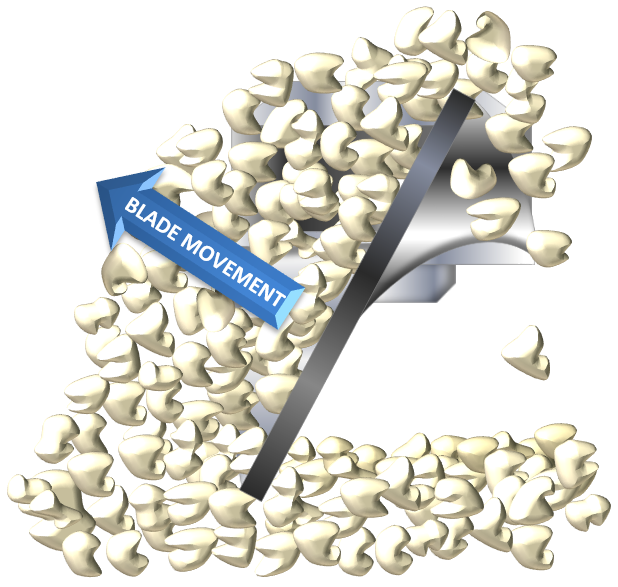Tim FreemanJune 24, 2020
Tag: Powder Flow , FT4 Powder Rheometer® , Freeman Technology , Tim Freeman
A diverse range of unit operations are employed to process and manipulate powders. These invariably subject materials to a wide range of conditions – from the relatively high and static compaction stresses observed in hoppers, to the low stress, dynamic conditions experienced during fluidisation. A thorough understanding of how a bulk material will behave over a range of conditions, and in various phases of flow – whether stationary, in motion or about to move – is therefore vital for designing and monitoring the unit operations and transfer systems that make up any given process.
Despite the extreme variations that exist between different operations, there is still a tendency to identify a simple, single parameter with which to characterise a powder. Single number characterisation, such as those categorising performance from ‘cohesive’ to ‘free flowing’, is unlikely to be sufficient in fully evaluating and predicting the performance of materials across a range of processes.
The key is to ensure compatibility between processing equipment and the characteristics of the powders it will handle. Such an approach requires a comprehensive understanding of the bulk behaviour of the materials in order to feed relevant information into process design and development from the outset.
FT4 Powder Rheometer®
The FT4 Powder Rheometer is a universal powder tester that provides automated, reliable and comprehensive measurement of bulk material characteristics. This information can be correlated with process experience to improve processing efficiency and aid quality control. Specialising in the measurement of dynamic flow properties, the FT4 also incorporates a shear cell, and the ability to measure bulk properties such as density, compressibility and permeability, enabling a comprehensive characterisation of a powder in a process relevant context.

During dilute phase pneumatic conveying, powder is transported in a fluidised state using air flow or a vacuum. In this process, there are a number of issues that can be encountered, such as choking, adhesion, or flooding. A powder’s permeability, and response to the presence of air, are therefore both likely to be critical properties. Through appropriate testing it is possible to determine whether a material can reach a fluidised state, and the air flow required to achieve this. Such testing supports the determination of optimal operating parameters.
Sensitivity to air can be quantified using the FT4’s Aeration test. In this test, Flow Energy is measured while air is introduced to the powder bed at increasing velocities. This enables simple and precise identification of when fluidisation occurs, as illustrated by the two examples in Figure 1.
Figure 1: Typical Aeration test result.

Fluidisation is considered to have occurred when Flow Energy reaches a near zero value. Both powders in Figure 1 reach a fluidised state, however for one powder this occurs at an air velocity of 4 mm/s, whereas the other requires a higher velocity of 8 mm/s.
A Permeability test directly measures Pressure Drop across the Powder Bed, quantifying a powder’s resistance to the transmission of air. A lower Pressure Drop, the grey trace in Figure 2, equates to higher permeability. This may be detrimental to a dilute phase pneumatic conveyance process as air will more readily pass through the powder bed, rather than efficiently transporting it.
Such information can be used for optimising process conditions and for specifying process parameters in pneumatic transfer systems.
Figure 2

Size Reduction
In some applications, a reduction in particle size prior to further processing can be beneficial. For example, size reduction can increase the dissolution rate of an active ingredient in a pharmaceutical blend, or prior to a mixing process, it can help improve homogeneity within the mixture. However, different size reduction techniques such as crushing, milling or grinding can have a different impact on the physical properties of the resulting particles, such as size and shape, and in turn on the associated flow properties.

Figure 3: Changes in Flow Energy due to size reduction processes.
Despite the benefits that can be associated with reduced particle size, powders with smaller particles typically behave in a more cohesive manner. For smaller and lighter particles, inter-particular forces may be relatively strong compared to the gravitational forces required to initiate and maintain flow. Measuring a powder’s compressibility provides information on the material’s response to being consolidated via an applied load and informs on the packing efficiency of the powder bed, determining the level of entrained air. Smaller particles typically result in a less efficient packing structure, which is usually associated with more cohesive materials.
Size reduction can also influence a powder’s resistance to flow, with smaller particles of the same morphology typically generating lower Flow Energy values as they can more easily be displaced by the rotating blade. However, changes in morphology and surface properties following size reduction can also have an impact on the friction and inter-locking between particles, as illustrated in Figure 3.
Dispensing
Dispensing of powders is a key operation in many industries to ensure the correct mass or volume of material is passed through to the next stage of a process. Understanding powder behaviour in this operation can significantly improve efficiency and productivity. In a typical dispensing operation, powder will pass through an opening and fill a container, mould or die below. The ease with which powder flows through the opening, and the rate that can be achieved, are critical to establishing and efficient process and achieving consistent filling performance.

Inter-particular cohesion and mechanical locking can determine whether particles will become trapped and form bridges when passing through an opening. The impact of these properties can be quantified by measuring the Specific Energy. This is measured as the FT4 blade moves upwards through the powder bed and the particles are able to flow in an unconfined state. Powders that generate high Specific Energy values are more likely to experience blockages and inhibited flow in this type of process.
Permeability measurements also provide an insight into the ability of the powder to displace air. Efficient filling requires air to pass readily through the powder bulk, not only to prevent flow being compromised at the dispenser outlet, but also enabling air to vacate the container thereby reducing the formation of air voids. In contrast to Pneumatic Conveyance described above, greater Permeability can be beneficial to dispensing operations.
Conclusions
The FT4’s multivariate test methods are ideally suited to characterising a range of process-relevant properties which will influence, and can be correlated to, performance in a variety of different processes. These correlations can be used to construct a design space of powder properties that pertain to good performance, against which both new formulations, or incoming or outgoing batches, can be assessed to predict downstream behaviour.
Related News:
Powder Flow: Manufacturing Support using the FT4 Powder Rheometer®
Developing a Design Space for OTC Manufacturing
Author Biography

Tim Freeman, Managing Director, Freeman Technology
Tim Freeman is Managing Director of powder characterisation company Freeman Technology for whom he has worked since the late 1990s. He was instrumental in the design and continuing development of the FT4 Powder Rheometer® and the Uniaxial Powder Tester. Through his work with various professional bodies, and involvement in industry initiatives, Tim is an established contributor to wider developments in powder processing.
Tim has a degree in Mechatronics from the University of Sussex in the UK. He is a mentor on a number of project groups for the Engineering Research Center for Structured Organic Particulate Systems in the US and a frequent contributor to industry conferences in the area of powder characterisation and processing. A past Chair of the American Association of Pharmaceutical Scientists (AAPS) Process Analytical Technology Focus Group Tim is a member of the Editorial Advisory Board of Pharmaceutical Technology and features on the Industry Expert Panel in European Pharmaceutical Review magazine. Tim is also a committee member of the Particle Technology Special Interest Group at the Institute of Chemical Engineers, Vice-Chair of the D18.24 sub-committee on the Characterisation and Handling of Powders and Bulk Solids at ASTM and a member of the United States Pharmacopeial (USP) General Chapters Physical Analysis Expert Committee (GC-PA EC).


Contact Us
Tel: (+86) 400 610 1188
WhatsApp/Telegram/Wechat: +86 13621645194
Follow Us:




 Pharma Sources Insight January 2025
Pharma Sources Insight January 2025


